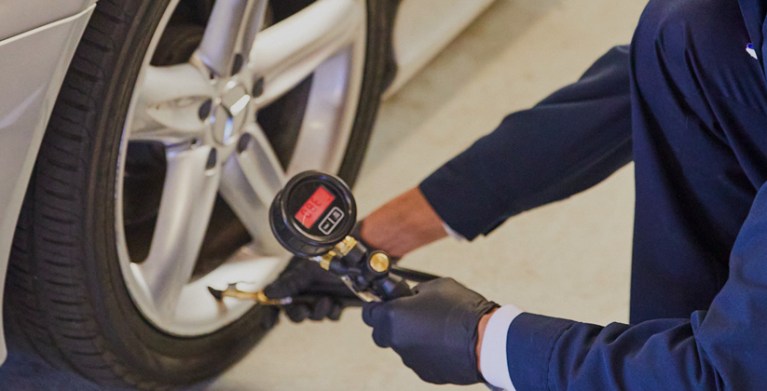Experience Precision with GMC Tire Service at Morris Tires
Experience Precision with GMC Tire Service at Morris Tires
Blog Article
Tire Solution: The Effect of Weather
When it involves ensuring optimum efficiency and safety on the road, comprehending the influence of weather on tire service is essential. From scorching heat to icy roads, each weather aspect can significantly affect tire performance and total driving experience. By delving right into the impacts of varying weather conditions on tires, vehicle drivers can obtain valuable understandings that may enhance their car's efficiency and longevity. In this conversation, we will check out the intricate connection in between weather and tire solution, shedding light on the importance of weather-specific tire upkeep practices and considerations.
Warm and Tire Efficiency
When exposed to high temperature levels, tires experience adjustments in performance that can considerably influence car security and handling. The warm generated from extended driving or heat problems causes the tire rubber to soften, causing lowered walk life and raised wear. As the rubber becomes softer, the tire's grip when driving lessens, impacting braking ranges and overall traction. In severe situations, excessive heat can also cause tire blowouts, posing a severe safety and security risk to the car and its owners.

Cold Weather Effects
Cold weather condition problems can have a considerable impact on tire efficiency and safety. In chilly weather, tires might also shed air pressure much more swiftly, which can influence managing and fuel efficiency.
To reduce the impacts of chilly climate on tires, it is important to routinely inspect tire stress and inflate them to the maker's advised levels. Using winter months or all-season tires developed for chilly climate problems can also improve grip and grip on icy or snowy roads. Correct tire maintenance, consisting of regular evaluations for wear and damages, comes to be a lot more crucial during cooler months to guarantee optimum efficiency and safety and security.
Rainy Issues Influence
Throughout stormy problems, tire efficiency and security can be substantially affected by the damp road surfaces and lowered presence. The step pattern of tires plays a critical function in keeping grip on damp roads. Tires with damaged treads are much more susceptible to hydroplaning, where a layer of water constructs up between the road and the tire surface, bring about loss of grip. To combat this, motorists should routinely evaluate their tires for appropriate walk depth and consider purchasing tires specifically designed for damp problems.
Additionally, stormy climate can also lower visibility, making it challenging for motorists to see the road in advance clearly (GMC Tire Service). In such problems, it is necessary to adjust driving speeds appropriately and keep a risk-free adhering to distance to permit abrupt stops. Properly filled with air tires can also assist in preserving control on damp roads by providing much better handling and grip
Snow and Tire Safety And Security
Snow-covered roads present one-of-a-kind difficulties for drivers, highlighting the relevance of proper tire option browse around here and maintenance. When driving in snowy conditions, having the appropriate tires can make a significant difference in security and performance. Wintertime tires are designed with special rubber substances and tread patterns to provide better grip on snow and ice contrasted to all-season tires. The deeper footsteps and sipes of winter tires assist hold the roadway much better, lowering the danger of gliding and sliding.

In addition, drivers should consider installing tire chains in extreme snowy problems. Tire chains supply added grip by grasping the snow and ice, improving security and control. It is vital to follow supplier instructions when setting up and using tire chains to avoid damage to the tires and automobile (GMC Tire Service). By choosing the right tires, preserving proper inflation, and taking into consideration extra grip help like tire chains, vehicle drivers can boost their security when navigating snow-covered roadways.
Weather-Related Tire Maintenance
Weather-related tire upkeep encompasses an array of techniques aimed at making sure optimal tire function and long life in different weather scenarios. One key facet of weather-related tire upkeep is tire pressure law. Checking tire tread regularly and replacing tires when walk wear reaches a specific depth is vital for keeping grip and stability in unfavorable climate.
Final Thought
In blog here final thought, weather have a substantial influence on tire efficiency and safety and security. From warm affecting tire pressure and use to chilly weather condition minimizing grip, it is necessary to think about the weather when preserving and making use of tires. Rainy problems can reduce grasp and lead to hydroplaning, resource while snow can increase the threat of accidents if tires are not appropriately equipped. Weather-related tire upkeep is important in making sure optimal performance and safety and security on the roads.
In this discussion, we will certainly check out the detailed partnership in between weather problems and tire service, dropping light on the significance of weather-specific tire maintenance practices and considerations.

Report this page